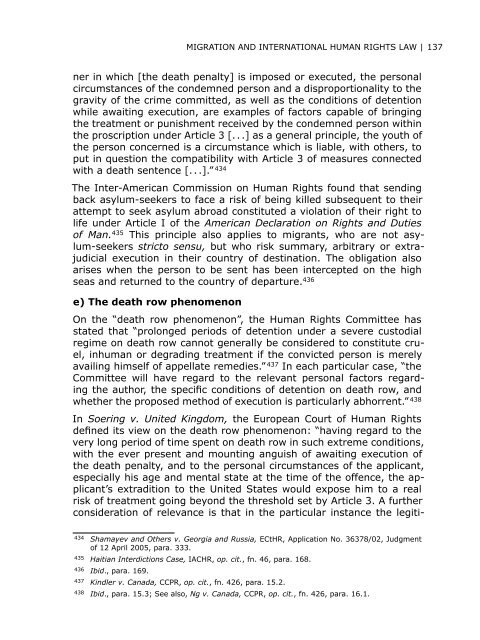Universal-MigrationHRlaw-PG-no-6-Publications-PractitionersGuide-2014-eng
Universal-MigrationHRlaw-PG-no-6-Publications-PractitionersGuide-2014-eng
Universal-MigrationHRlaw-PG-no-6-Publications-PractitionersGuide-2014-eng
You also want an ePaper? Increase the reach of your titles
YUMPU automatically turns print PDFs into web optimized ePapers that Google loves.
MIGRATION AND INTERNATIONAL HUMAN RIGHTS LAW | 137<br />
ner in which [the death penalty] is imposed or executed, the personal<br />
circumstances of the condemned person and a disproportionality to the<br />
gravity of the crime committed, as well as the conditions of detention<br />
while awaiting execution, are examples of factors capable of bringing<br />
the treatment or punishment received by the condemned person within<br />
the proscription under Article 3 [. . .] as a general principle, the youth of<br />
the person concerned is a circumstance which is liable, with others, to<br />
put in question the compatibility with Article 3 of measures connected<br />
with a death sentence [. . .].” 434<br />
The Inter-American Commission on Human Rights found that sending<br />
back asylum-seekers to face a risk of being killed subsequent to their<br />
attempt to seek asylum abroad constituted a violation of their right to<br />
life under Article I of the American Declaration on Rights and Duties<br />
of Man. 435 This principle also applies to migrants, who are <strong>no</strong>t asylum-seekers<br />
stricto sensu, but who risk summary, arbitrary or extrajudicial<br />
execution in their country of destination. The obligation also<br />
arises when the person to be sent has been intercepted on the high<br />
seas and returned to the country of departure. 436<br />
e) The death row phe<strong>no</strong>me<strong>no</strong>n<br />
On the “death row phe<strong>no</strong>me<strong>no</strong>n”, the Human Rights Committee has<br />
stated that “prolonged periods of detention under a severe custodial<br />
regime on death row can<strong>no</strong>t generally be considered to constitute cruel,<br />
inhuman or degrading treatment if the convicted person is merely<br />
availing himself of appellate remedies.” 437 In each particular case, “the<br />
Committee will have regard to the relevant personal factors regarding<br />
the author, the specific conditions of detention on death row, and<br />
whether the proposed method of execution is particularly abhorrent.” 438<br />
In Soering v. United Kingdom, the European Court of Human Rights<br />
defined its view on the death row phe<strong>no</strong>me<strong>no</strong>n: “having regard to the<br />
very long period of time spent on death row in such extreme conditions,<br />
with the ever present and mounting anguish of awaiting execution of<br />
the death penalty, and to the personal circumstances of the applicant,<br />
especially his age and mental state at the time of the offence, the applicant’s<br />
extradition to the United States would expose him to a real<br />
risk of treatment going beyond the threshold set by Article 3. A further<br />
consideration of relevance is that in the particular instance the legiti-<br />
434 Shamayev and Others v. Georgia and Russia, ECtHR, Application No. 36378/02, Judgment<br />
of 12 April 2005, para. 333.<br />
435 Haitian Interdictions Case, IACHR, op. cit., fn. 46, para. 168.<br />
436 Ibid., para. 169.<br />
437 Kindler v. Canada, CCPR, op. cit., fn. 426, para. 15.2.<br />
438 Ibid., para. 15.3; See also, Ng v. Canada, CCPR, op. cit., fn. 426, para. 16.1.



